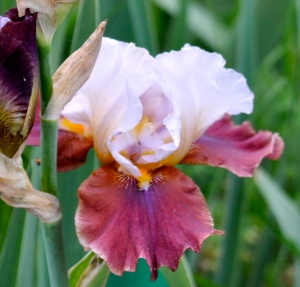With their swordlike leaves and showy flowers, bearded iris are an eye-catching addition to any garden. They're easy to plant, require minimum care, and readily multiply. Even if you grow nothing but bearded irises, you can enjoy a remarkable range of color and a bloom season extending for months. These perennials flourish in USDA Zones 3-9.
Bearded irises are identified by thick, bushy "beards" on each of the falls (lower petals) of the blossoms. The flowers are constructed with three upright "standard" petals and three drooping "fall" petals, which are often different colors. The falls may be "bearded" or not. 

Originally, most bearded irises were native to central and southern Europe. Some bearded irises are "rebloomers", blooming again in the summer, fall or winter. Additional water and fertilizer applied during the late spring and summer months encourages them to bloom again. There are rebloomers available which will perform in all but the coldest climates. Spring planting is discouraged but can be done under abnormal circumstances, however it often results in lack of bloom for a season or two and slow establishment.
Bearded iris need a balanced, well-drained soil but are very adaptable to a variety of soil types. Raised beds can help with drainage and are a MUST for areas with high rainfall. Iris, like most perennials, prefer neutral to slightly acidic soil (pH of 6.8 - 7.0 is ideal). Heavy clays need to be amended with gypsum or coarse sand to aid drainage. Iris can be mulched lightly (for winter protection and weed control) as long as the mulch does not cover the rhizome. Once winter is over, it is wise to remove the mulch.
PLANTING
Plant bearded iris in mid summer to early fall, spacing plants 1 to 2 feet apart, depending on variety. Excellent soil drainage is a must. Prepare garden bed by using a garden fork or tiller to loosen soil to a depth of 12 to 15 inches, then mix in a 2- to 4-inch layer of compost or bone meal. If planting a rhizome (fleshy root), dig a shallow hole 10 inches in diameter and 4 inches deep. Make a ridge of soil down the middle and place the rhizome on the ridge, spreading roots out to support the plant, replace the soil, firmly pack around the roots to remove air pockets and water liberally. In clay soil, the top of the rhizome should be exposed. In sandy soil, rhizomes can be buried with a thin layer of soil. If planting container-grown plants, set the plant so the rhizome is at the soil surface. Water thoroughly.
DO NOT plant bearded iris in a low area; they will not tolerate standing water. 14-18” is a good distance between rhizomes. For mass or clump style plantings, plant rhizomes in a triangular fashion about 6” apart. In areas of intense summer heat or light soils, irises can be planted deeper (no more than 1” below the soils surface) to avoid scalding.
CARE
Apply a thin layer of compost around the base of plants each spring, leaving the rhizome (fleshy root) exposed. As flowers fade, cut back the flower stalks to the base of the plant, making sure to leave the fan leaves. To encourage a second bloom on reblooming varieties, promptly remove faded flowers and maintain consistent watering throughout the summer. In autumn, trim away dead foliage and prune back healthy leaves to a height of 4 to 5 inches. Once the soil has frozen, apply a layer of mulch to help prevent roots from heaving out of the soil during alternate freezing and thawing. If heaving occurs, don't try to force plants back into the soil. Instead, cover rhizomes and exposed roots with soil. Divide bearded iris every 4 to 5 years, preferably in late summer. Each division should have one or two leaf fans. Older rhizomes that have few white feeding roots should be discarded.
Specific fertilizer recommendations depend on your soil type, but bone meal, superphosphate and 6-10-10 are all effective. A light application in the early spring and a second light application about a month after bloom will reward you with good growth and bloom. Avoid using anything high in nitrogen, as nitrogen encourages rot problems.
We have and sell over 300 varieties of Bearded Irises growing in our gardens, with more being added this Fall.
If you enjoyed this article, want to know more about this or other related interesting topics, please like and share this article. Be sure to like us, so you don’t miss anything, we are Sweet Basil Farm & Gardens, on Facebook and other social media. We are a local producer of farm fresh fruits and vegetables and members of the American Poultry Association, licensed by the Georgia Dept. of Agriculture as Poultry Dealers and Brokers, and a proud member of the Georgia Grown program, a division of the Georgia Dept. of Agriculture. We also breed, sell and ship poultry, pet pigs, bearded irises and much more. We have an 80 acre working farm, putting great emphasis on all natural gardening and livestock management practices. An 1840s general store is situated on our property, and serves as our on-site farmer’s market. Conveniently located off of Interstate 75 near the Johnstonville Rd exit (#193). We are six miles west, located in Barnesville, Lamar County, Georgia.

No comments:
Post a Comment